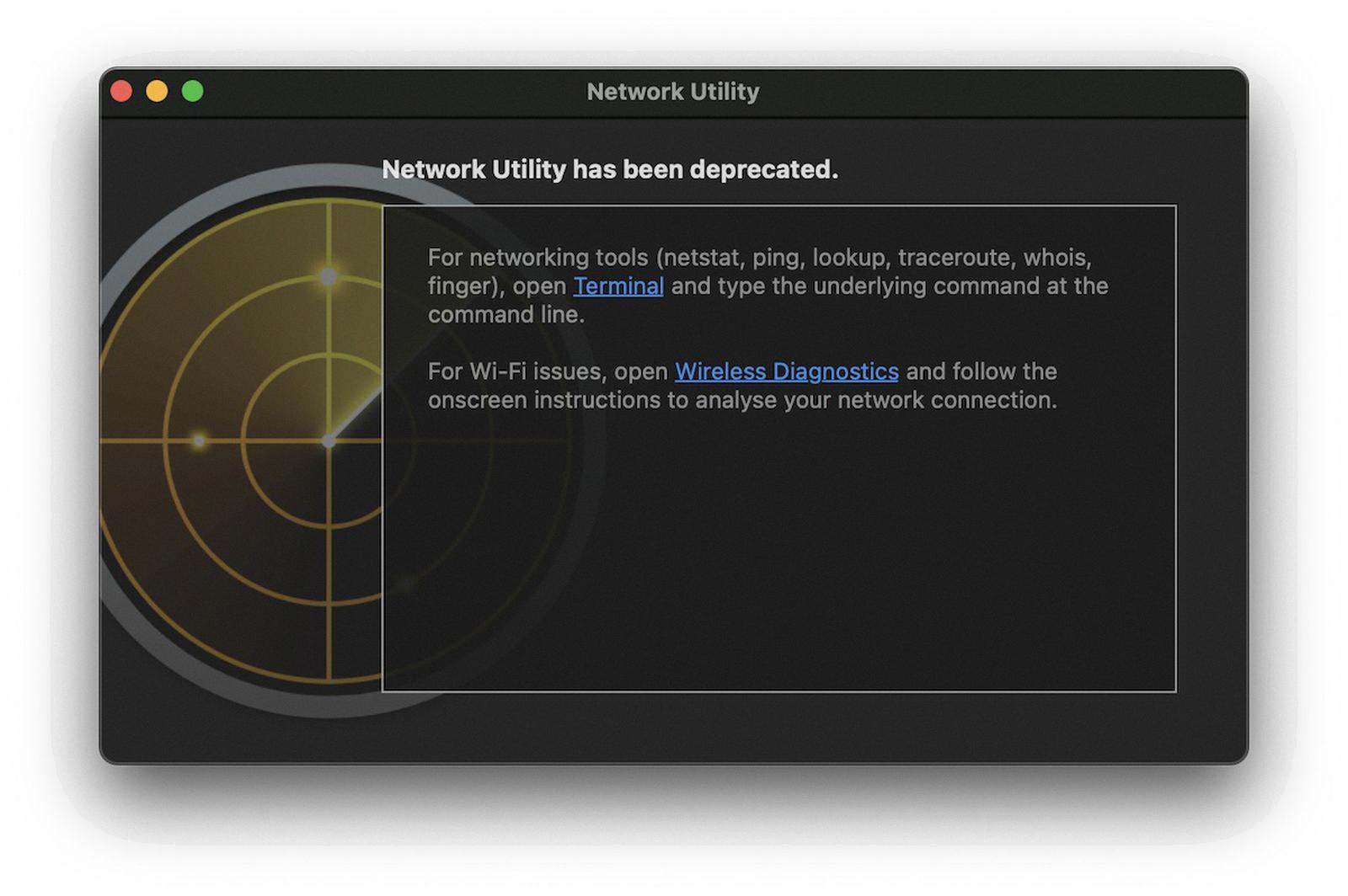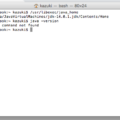When it comes to managing your network settings on a Mac, Network Utility is an indispensable tool. However, with the release of macOS Big Sur, Apple has decided to deprecate this long-standing app, leaving users searching for alternatives. In this article, we’ll explore the features of Network Utility and suggest a viable replacement.
Network Utility, which was accessible through the Applications > Utilities folder, provided users with a range of network troubleshooting and configuration options. With this tool, you could easily modify DNS server settings, configure IP addresses, and diagnose connection issues. It was particularly useful for checking the status of your network connection, whether it was Ethernet or Wi-Fi.
To access Network Utility, you simply had to navigate to the Apple menu, select System Preferences, and click on Network in the sidebar. From there, you could access various network settings and view detailed information about your network connection. This information was invaluable for troubleshooting any connectivity problems you might encounter.
However, with the arrival of macOS Big Sur, Network Utility has been deprecated, leaving users wondering how they can perform similar tasks. Fortunately, there is a viable alternative that can provide the same functionality – Terminal.
Terminal is a powerful command-line tool on Mac that allows you to execute various commands and perform a wide range of tasks. For network troubleshooting, Terminal offers the same functionalities as Network Utility, ensuring you don’t lose any critical features.
One of the key Network Utility features that can be replicated in Terminal is the ability to ping a network address or domain. By using the “ping” command followed by the address or domain name, you can check the connectivity between your Mac and the target address. This can help identify any network issues or latency problems.
Additionally, Terminal can also replicate the functionality of the Lookup tool in Network Utility. By using commands like “nslookup” or “dig,” you can retrieve DNS information, including IP addresses and domain records. This is particularly useful for troubleshooting DNS-related problems or verifying the accuracy of your DNS configuration.
It’s worth mentioning that while Terminal provides the same capabilities as Network Utility, it does require a bit more technical knowledge and familiarity with command-line interfaces. However, with a little practice and the help of online resources, you can quickly become proficient in using Terminal for network troubleshooting and configuration.
While Network Utility may no longer be available in macOS Big Sur, there is no need to panic. Terminal, a built-in command-line tool on Mac, can serve as an effective replacement for managing your network settings. By leveraging Terminal’s commands, such as ping and lookup, you can perform similar operations and troubleshoot network issues with ease. So, don’t let the absence of Network Utility hinder your network management – embrace Terminal and continue to take control of your Mac’s network settings.
What is Network Utility On Mac?
Network Utility is a versatile tool available on Mac that provides a range of functions to view and modify network settings. It serves as a handy solution for network troubleshooting and configuration tasks. Here are some key features and functionalities of Network Utility:
1. Ping: Network Utility allows you to perform a ping test to check the connectivity between your Mac and a specific IP address or domain. This helps in diagnosing network connection issues and determining the response time.
2. Port Scan: With Network Utility, you can conduct a port scan to identify open ports on a specific IP address or domain. This aids in identifying potential security vulnerabilities and ensuring the proper functioning of network services.
3. Traceroute: The tool enables you to trace the route taken by network packets from your Mac to a specified IP address or domain. Traceroute provides valuable insights into the network path, helping pinpoint latency or connectivity problems.
4. Netstat: Network Utility provides a netstat function that displays detailed information about the network connections and routing tables on your Mac. This can be useful in monitoring network activity, identifying active connections, and troubleshooting network-related issues.
5. Whois: This feature allows you to retrieve information about a specific domain, including the domain registrar, contact details, and registration status. It can be helpful for investigating domain ownership or troubleshooting domain-related problems.
6. Lookup: Network Utility offers a lookup feature that performs DNS (Domain Name System) queries. You can use this to retrieve information such as IP addresses associated with a domain, or to troubleshoot DNS-related issues.
7. DNS: The tool also allows you to configure DNS settings, including adding or modifying DNS server addresses. This can be beneficial if you wish to use custom DNS servers or troubleshoot DNS resolution problems.
8. Wi-Fi Scan: Network Utility provides a Wi-Fi scan function that displays a list of nearby Wi-Fi networks, along with relevant information such as signal strength, channel, and security type. This assists in analyzing Wi-Fi networks and optimizing network performance.
Network Utility on Mac is a comprehensive tool that empowers users to diagnose network issues, gather network-related information, and configure network settings for enhanced performance and troubleshooting.

How to Get to Network Utility On Mac?
To access the Network Utility on your Mac, you can follow these steps:
1. Click on the Apple menu located at the top-left corner of your screen.
2. From the drop-down menu, select “System Preferences.”
3. In the System Preferences window, click on the “Network” icon. It is usually represented by a globe or a series of connected dots.
4. The Network window will open, displaying your network settings and connections. You will see a list of available network interfaces on the left-hand side of the window.
5. To access the Network Utility, click on the “Advanced” button in the bottom-right corner of the Network window.
6. A new window will appear with several tabs. Click on the “Proxies” tab.
7. At the bottom of the Proxies tab, you will find a button labeled “Network Utility.” Click on it to open the Network Utility tool.
Alternatively, you can also use Spotlight, the search feature on your Mac, to quickly access Network Utility. Simply press Command + Spacebar to open Spotlight, then type “Network Utility” in the search bar. Spotlight will display the Network Utility application, and you can click on it to open the tool.
Once you have opened the Network Utility, you can use it to perform various network-related tasks, such as checking network connections, pinging an IP address, performing traceroutes, and more.
What Happened to Mac Network Utility?
In macOS Big Sur, Apple has made the decision to deprecate the Network Utility app. This means that the app is no longer functioning in the first developer beta of the operating system. The deprecation of the Network Utility app signifies that Apple has chosen to no longer support or maintain it.
The Network Utility app, which has been a long-standing tool in macOS, provided users with various network-related functionalities and tools. It allowed users to perform tasks such as ping, trace route, netstat, and lookup domain names. These features were useful for network troubleshooting and diagnostics.
However, with the deprecation of the Network Utility app, users will need to find alternative solutions for their network-related tasks. Fortunately, macOS still provides other built-in tools and utilities that can be used for similar purposes. Some of these alternatives include:
1. Terminal: macOS comes with a powerful command-line interface called Terminal. It provides access to a wide range of network-related commands that can be used for diagnostics and troubleshooting. Some commonly used commands include ping, traceroute, netstat, nslookup, and curl.
2. Network Diagnostics: macOS also includes a built-in Network Diagnostics tool that can help identify and fix common network issues. It can be accessed by going to the Apple menu, selecting System Preferences, and then clicking on Network. From there, click on the Assist me button and choose Diagnostics. This tool can run various tests to check your network connection and suggest potential solutions.
3. Third-party apps: There are numerous third-party network utility apps available in the Mac App Store that can provide similar functionalities to the deprecated Network Utility app. These apps can offer features like ping, trace route, port scanning, and more. Some popular options include iNet Network Scanner, IP Scanner, and Network Analyzer.
It’s important to note that while the Network Utility app has been deprecated, it may still work in older versions of macOS. However, it’s recommended to explore alternative solutions to ensure compatibility and support with future macOS updates.
The Network Utility app has been deprecated in macOS Big Sur, and it is no longer functional in the first developer beta. Users can rely on built-in tools like Terminal and Network Diagnostics, or explore third-party network utility apps for their networking needs.
What is The Replacement For Network Utility?
The replacement for Network Utility is the Terminal application, which can perform all the functions of Network Utility and even more. Terminal is a powerful command-line tool that allows users to interact with their computer through text-based commands. It provides a wide range of network utility functions, ensuring that users do not lose any functionality when transitioning from Network Utility.
Here are some of the key features and functionalities of Terminal as a replacement for Network Utility:
1. Ping: Terminal offers a ping command that performs the same operations as the Network Utility tool. By using the ping command followed by a specific IP address or domain name, you can check the connectivity to a remote server and measure the response time. This allows you to troubleshoot network issues and determine the reachability of a host.
2. Lookup: Terminal also provides a command-line equivalent to the Lookup tool in Network Utility. By using the nslookup command followed by a domain name, you can retrieve information about the IP address associated with the domain, as well as other DNS-related details. This helps in analyzing DNS configurations and resolving domain name issues.
3. Traceroute: Another useful feature of Terminal is the traceroute command, which allows you to identify the path that network packets take from your computer to a destination IP address or domain. This helps in diagnosing network latency and identifying network hops or bottlenecks along the route.
4. Network scanning: Terminal provides various commands like nmap, netstat, and tcpdump, which enable network scanning and monitoring. These commands allow you to discover open ports, view active network connections, capture network traffic, and analyze network protocols. These functionalities are crucial for network security and troubleshooting purposes.
5. Scripting and automation: Terminal’s command-line interface is highly scriptable, allowing you to write custom scripts and automate network-related tasks. You can create powerful scripts using languages like Bash, Python, or Perl to perform advanced network operations, automate repetitive tasks, and gather network statistics.
Terminal is a versatile replacement for Network Utility, offering a comprehensive set of network utility functionalities. Its command-line interface provides power users and network administrators with extensive control and flexibility in managing and troubleshooting networks.
Conclusion
Mac Network Utility is a versatile and essential tool for Mac users to manage and troubleshoot their network settings. It offers a range of features that allow users to view and modify their network configuration, such as changing DNS servers and configuring IP addresses. The tool also provides valuable information about the status of network connections, which can be helpful in diagnosing and resolving connectivity issues.
However, with the release of macOS Big Sur, Apple has deprecated the Network Utility app, rendering it non-functional. But fear not, as Terminal can serve as a viable replacement. Terminal commands like ping can perform the same operations as the Network Utility tool, ensuring that users do not lose any functionality. Additionally, Terminal can also replicate the Lookup tool, further enhancing its usefulness.
While the Network Utility app may no longer be available in macOS Big Sur, Mac users can still effectively manage and troubleshoot their network settings using Terminal. This ensures that users can continue to enjoy a seamless network experience on their Mac devices.








